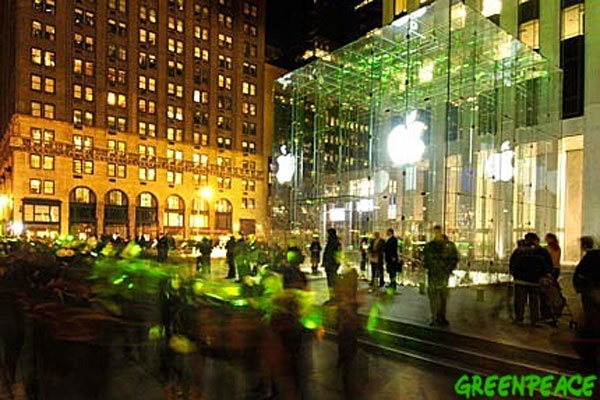Greenpeace ranks Apple as greenest electronics maker
"It's time for a little less conversation and a lot more action on removing toxic chemicals," said Casey Harrell, Greenpeace International Electronics campaigner. "Apple is leading and HP is playing catch up, but the lack of action from other companies is ensuring that customers and the environment are still losing out."
The Cupertino-based Mac and iPhone maker received gold stars in all four categories identified in Greenpeace's latest electronics guide: desktops, notebooks, cellphones and displays. In each case, the firm said Apple's products were free of the worst hazardous substances plaguing modern-day electronics.
"Companies need to support legislative bans to ensure a consistent phase out of PVC and BFRs across all electronic products," Harrell added. "Sony Ericsson and Apple are already calling on EU institutions to support such a ban. Other big players, such as HP and Dell – who have so far been silent - and Acer, need to ensure the ban is passed in the European Union parliament."
Saying Greenpeace and Apple have a storied and muddied past would be an understatement. This week's announcement follows years of pressure on the part of Greenpeace, in which the advocacy group made Apple its primary target in the wake of the iPod boom and the Mac's return to stardom.
In August of 2006, Greenpeace issued a report which gave Apple a 2.7 out of 10 environmental-friendly rating, condemning the electronics maker with low scores in almost all of its criteria, including the use of toxic chemicals, recycling, and the quality of its take-back programs.
"For a company that claims to lead on product design, Apple scores badly on almost all criteria," the group wrote in the report. "The company fails to embrace the precautionary principle, withholds its full list of regulated substances and provides no timelines for eliminating toxic [chemicals]."
Greenpeace then kicked off a "Green my Apple" campaign that saw it set up shop at that year's MacExpo in London, in which members began distributing organic green apples to attendees in an effort to raise awareness about the use of toxic chemicals in Apple's products. The effort was short-lived, however, as Greenpeace was abruptly asked to leave the show and forced to shut down its operation.
In the month's that would follow, the group would pull similar publicity stunts such as "greening" Apple's flagship store on Fifth Avenue New York City by shining green spotlights into the location's 32-foot glass cube. A similar protest was made at Apple's San Francisco-based flagship shop during the January 2007 Macworld Expo, albeit to less success due to technical difficulties.
Greenpeace activists demonstrate with "green" light at the 5th Avenue Apple store in Manhattan.
Nevertheless, the negative publicity generated by Greenpeace would force Apple Chief Executive Steve Jobs to issue an open letter to customers and shareholders in May of 2007, in which he admitted that the company had not been forthright on its environmental policy. As part of the letter, Jobs outline a timetable for the removal of toxic chemicals from the company's products, including arsenic, mercury, polyvinyl chloride (PVC), and brominated flame retardants (BDRs).
In an interview this past September, Jobs, along with Chief Operating Officer Tim Cook, would expand on his company's newfound environmentally conscious ways while acknowledging that Greenpeace's targeting of his company played a significant role in promoting its green focus in public.
After Greenpeace criticized Apple for the use of toxic chemicals in its products, Jobs said he turned to former vice president Al Gore, a member of his company's board of directors and winner of the Nobel Peace Prize for his work on climate change. Gore reportedly told Jobs to do what he does, and not get into a "mud-slinging war" with the environmental organization.
In response, Apple began mentioning its products' environmental impact with a scorecard at each keynote. Jobs argued that his company had always been green, but in the past it didn't make it a point to mention it in public. He said the company's tight-lipped approach, particularly on public policy issues, hurt its image with environmental organizations.
"We tend to report rather than predict," Jobs said. "You won't see us out there saying what the PC is going to look like in 2016. We quietly go try to invent the PC for 2016."
Another report highlighted the company's reporting of hardware carbon emissions, a new disclosure that was revealed by the company that same week. It noted the use of Apple products by consumers accounts for more than half of Apple's annual 10.2 million tons of carbon emissions. Apple's environmental Web site states that less than 5 percent of the company's emissions come from manufacturing facilities, while more than 95 percent of its greenhouse gases are from the products it sells.
Cook said that companies often focus on the wrong issues. He gave the example of installing motion detectors in a conference room, to automatically turn off the lights in a room when no one is there. But the real carbon footprint, he said, comes from the products themselves.
"Making products cleaner involves real engineering," Cook said. "It's about innovating, and it's hard work."
 Sam Oliver
Sam Oliver











 Mike Wuerthele
Mike Wuerthele

 Malcolm Owen
Malcolm Owen
 Chip Loder
Chip Loder

 William Gallagher
William Gallagher
 Christine McKee
Christine McKee
 Michael Stroup
Michael Stroup






